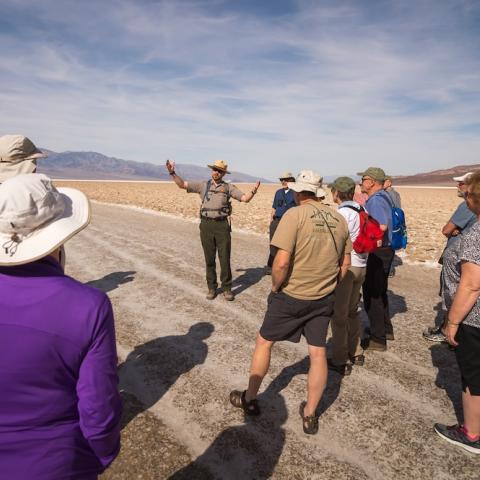
Runoff from Tropical Storm Hilary created a raging river at Zabriskie Point in Death Valley National Park on Sunday/NPS
Death Valley National Park closed Sunday as torrential rains from Tropical Storm Hilary pummeled the park, spurring flash floods that were undercutting roads and prompting park officials to urge anyone still in the park to "turn around, don't drown." Mojave National Preserve, Lake Mead National Recreation Area, and Joshua Tree National Park all had closed a day earlier because of the historic storm.
"The park received 1 inch of rain by mid-day Sunday, with unprecedented levels of rainfall predicted over Sunday night. California Highway 190 is also closed," Death Valley spokesperson Abby Wines said. "Park rangers are reminding travelers to 'Turn around, don’t drown' [rather than trying to drive through the torrents]. Flash floods are rivers of mud and rocks that can easily sweep cars off roads. Emergency responders may not be able to reach people in need."
The storm also brought strong winds into the area, with 60 mph gusts possible, the National Weather Service warned.
"Minor flooding of some roads is occurring in Death Valley National Park, and potentially along parts of the Amargosa River," the weather service reported at midday. "Death Valley National Park is the most likely place to experience minor flooding. Some locations that will experience flooding include Furnace Creek, Stovepipe Wells, Shoshone, Texas Springs Campground, Panamint Springs, Darwin, Mesquite Springs Campground, Death Valley Junction, Trona, Scottys Castle, Amargosa Valley, Tecopa and Searles Valley."
At Mojave National Preserve, National Park Service staff were particularly concerned about the potential for "debris flows" washing off the roughly 90,000 acres covered by the York Fire earlier this month.
"The major and historic flood impacts from Hurricane Hilary are creating a hazardous situation of flooded roads, missing roadway, debris on roads," said the Mojave Preserve staff on its website.
A flash-flood watch issued Sunday at 2:30 p.m. local time for the region was to run until 5 p.m. Monday.
"Outdoor recreation will be very dangerous this weekend across San Bernardino County and is strongly ill-advised in the Mojave National Preserve and Joshua Tree National Park," the weather service warned.
In these desert Southwest parks, where annual rainfall ranges from 2.2 inches at Death Valley and 4.4 inches at Joshua Tree to 3.5 inches in lower elevations of Mojave Preserve, Hilary was threatening to bring 6 inches or more of rain by Sunday night into Monday. "Dangerous to catastrophic flooding is expected," the National Hurricane Center predicted.
The 1.04 inches of rain received at Furnace Creek in Death Valley by 1:30 p.m. Sunday was roughly half of the rainfall the park receives all year.
"The park might receive one to three more inches of rain Sunday night. For comparison, Furnace Creek’s average annual rainfall is 2.2 inches," said Wines."This unprecedented rainfall is due to Hurricane Hilary."

A National Park Service vehicle parked in front of active flooding on Badwater Road, near the junction with CA-190/NPS




 Support Essential Coverage of Essential Places
Support Essential Coverage of Essential Places







Comments
So now we've got imbedded video which is cool. The scroll down is a bit clunky as I could not maximize the window FYI.